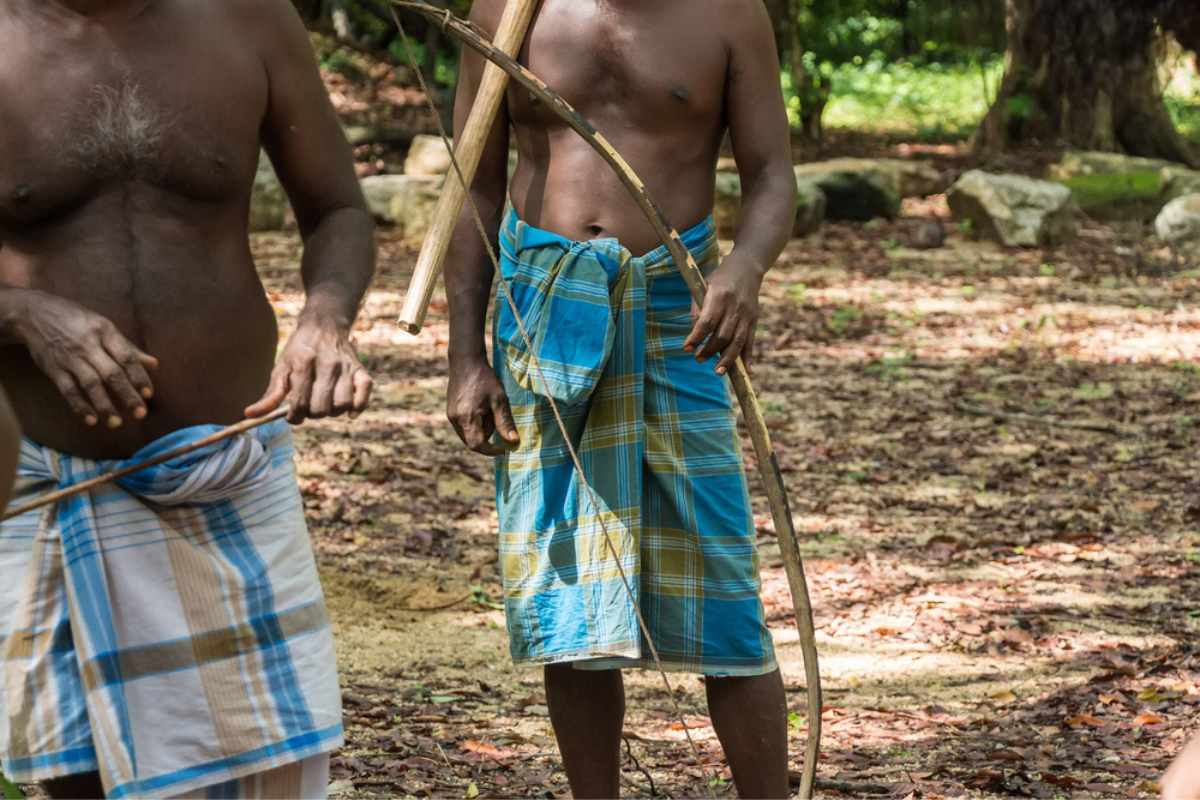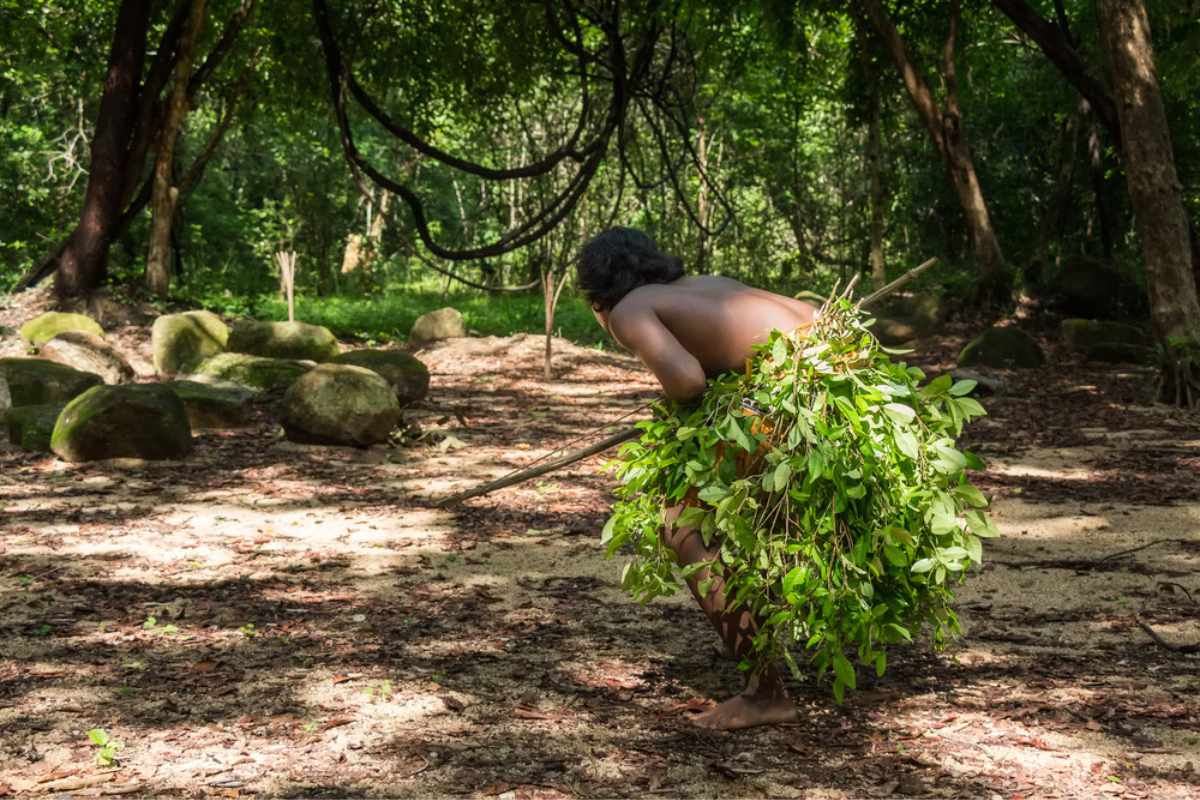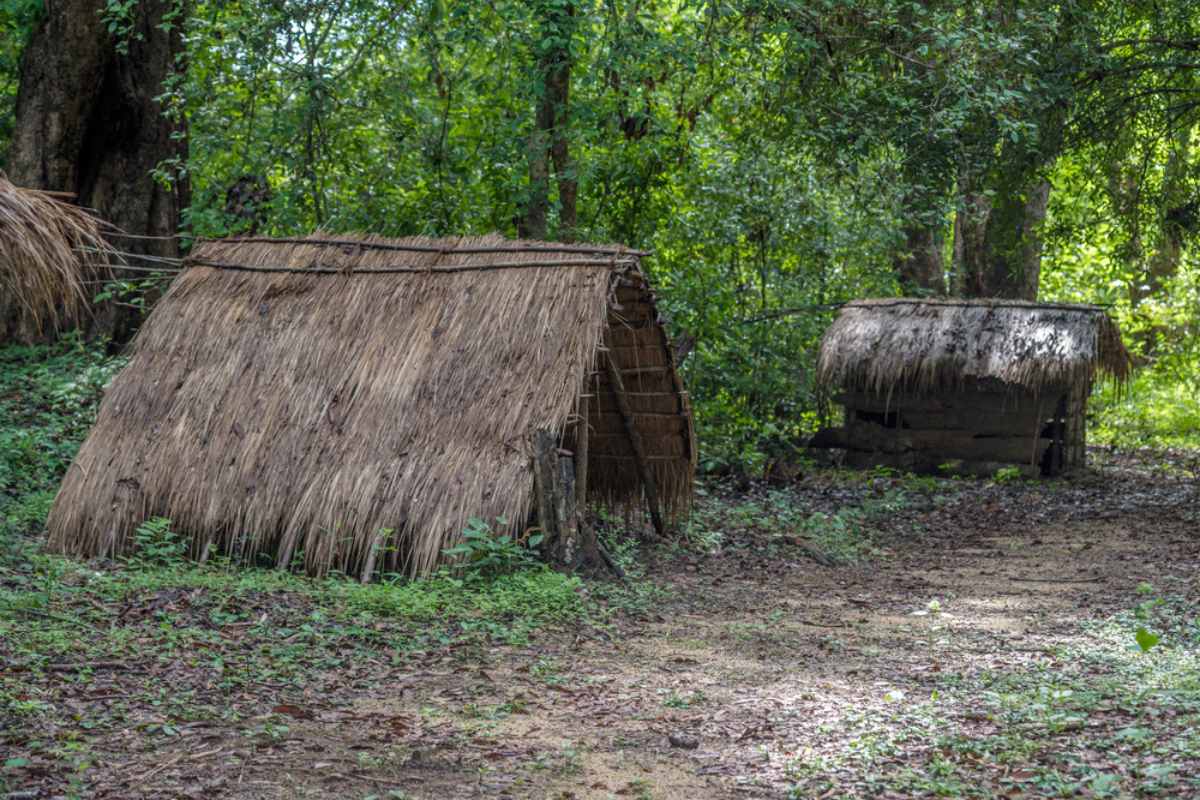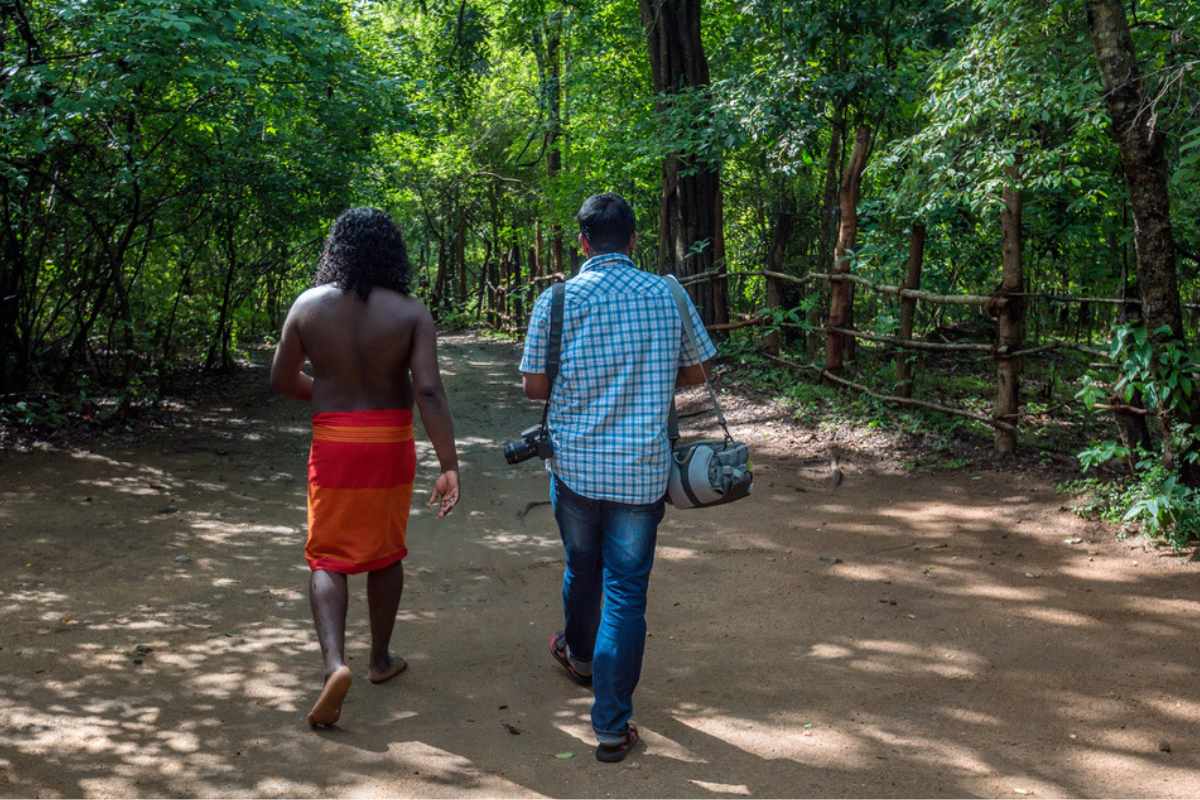
In the heart of Sri Lanka’s lush forests and secluded landscapes lives a community whose lineage traces back to the origins of human civilization on the island—the Veddas. These indigenous people, often perceived as living relics of a bygone era, offer a window into a past that is both fascinating and enlightening. This article delves into the world of the Veddas, exploring their rich history, unique culture, and the challenges they face in the modern world.
The Historical Roots of the Veddas
Tracing the origins of the Veddas is akin to peeling back the layers of Sri Lanka’s ancient history. These indigenous people, often perceived as living relics of a bygone era, are a crucial link to the island’s prehistoric past.
Deep-Rooted Ancestry
The lineage of the Veddas takes us back to the very dawn of human civilization in Sri Lanka. Archaeological evidence and historical estimates suggest that their origins could date back to around 16,000 BC, placing them among the oldest known inhabitants of the island. This deep-rooted ancestry establishes the Veddas as witnesses to the island’s historical transformations and active participants in its rich tapestry of human evolution.
From Hunters to Legends
Initially, hunter-gatherers, the Veddas maintained a lifestyle closely tied to the forests and the natural environment of Sri Lanka. The word ‘Veddah’ itself, derived from the Sanskrit ‘Vyadha’, meaning a hunter with a bow and arrow, is a testament to their traditional way of life. This vocabulary signifies their hunting and survival skills and highlights their intimate connection with nature, a cornerstone of their cultural identity.
The Veddas and the Sinhalese
The Veddas stand distinct from the Sinhalese, who comprise most of Sri Lanka’s population. While the Sinhalese speak an Indo-Aryan language and claim Aryan descent, the Veddas are linked to the Austro-Asiatic groups. This distinction points to a diverse ancestral heritage, setting the Veddas apart in the cultural mosaic of Sri Lanka. Their unique genetic and cultural lineage underscores the diversity that has long been a hallmark of the island’s history.
Myth and History
The Mahawamsa, an important chronicle in Sri Lankan history, offers a mythical yet intriguing connection between the Veddas and the island’s early rulers. According to this narrative, the Veddas are linked to Prince Vijaya, the legendary first king of Sri Lanka. The story goes that Vijaya encountered and mingled with the indigenous people upon his arrival on the island, leading to the formation of the Vedda community. This intertwining of myth and history enriches the Veddas’ cultural narrative and embeds them firmly in the national consciousness of Sri Lanka.
Archaeological and Genetic Insights
Recent archaeological and genetic studies have provided new insights into the origins and evolution of the Veddas. These studies suggest a continuous presence and adaptation of the Veddas throughout Sri Lanka’s history, offering a more nuanced understanding of their role in the island’s past. As modern science unravels the mysteries of their origins, the Veddas emerge as remnants of an ancient lineage and as active shapers of Sri Lanka’s historical journey.
Vedda Society
The Vedda society is a fascinating example of a community living harmoniously with nature. Their traditional practices, social structures, and spiritual beliefs are intricately linked to the forests and wildlife of Sri Lanka, demonstrating a profound understanding and respect for their natural surroundings. Uru Varige Vanniyalaththo, the current leader of the Vedda community, resides in Dambana. Dambana is a well-known village in Sri Lanka, often recognized as a significant settlement of the Vedda people. As the leader, Uru Varige Vanniyalaththo plays a pivotal role in upholding and preserving the traditions, culture, and rights of the Vedda community. His leadership is key in maintaining the identity of the Veddas in the face of modern challenges and ensuring that their unique heritage continues to be a vibrant part of Sri Lanka’s cultural mosaic. His residence in Dambana symbolizes the continuing presence and resilience of the Vedda community in their traditional lands.
Vadda Population
As the indigenous people of Sri Lanka, the Vedda community constitutes a tiny percentage of the national population. As of recent estimates, they account for less than 1% of Sri Lanka’s total population. This minority status highlights the vulnerability of their cultural and societal practices as they navigate the challenges of preserving their unique heritage and traditions in a rapidly modernizing world. Their small numbers further emphasize the importance of efforts to protect and promote their rights, language, and traditional way of life, ensuring that this rich and ancient culture continues to be a part of Sri Lanka’s diverse tapestry.
The Core of Vedda Existence
For the Veddas, the forest is not just a resource but a sacred space, an integral part of their existence. Their day-to-day activities, from hunting to gathering, are performed with a deep sense of respect and sustainability. This relationship with nature is not just about survival; it is a spiritual connection, with the forest seen as a giver of life and a protector of their community. This intrinsic bond has shaped their lifestyle, making them stewards of the land they inhabit.
Clans and Family Structures
The social structure of the Veddas is characterized by small, close-knit family units that form clans. These clans, each with its territory within the forest, function as independent units but are connected through a broader sense of community. The division of labour within these groups is directly influenced by their environment, with roles and responsibilities tailored to sustain their natural resources. This communal living fosters a strong sense of belonging and commitment among its members, ensuring their environment and cultureconservation.
Spiritual Beliefs and Rituals
The Veddas’ spiritual beliefs are deeply rooted in nature. They perceive the natural world as imbued with divine presence, where every tree, rock, and river has spiritual significance. This reverence is evident in their rituals, which often involve offerings and prayers to the spirits of nature. Such practices highlight their belief in a world where humans and nature exist in a symbiotic relationship, each nurturing and supporting the other.
Hunting, Gathering, and Chena Cultivation
The Veddas’ approach to hunting and gathering is a testament to their sustainable lifestyle. They hunt only for what they need, following strict taboos that prevent overhunting and ensure wildlife conservation. Similarly, their gathering practices are selective, taking care not to harm the plants they rely on. Chena cultivation, a form of shifting agriculture, is another key aspect of their lifestyle. This method, which involves clearing a small forest area for cultivation before moving on to allow the land to regenerate, reflects their understanding of ecological balance and sustainability.
Areas where Vedda lives
The Vedda community, indigenous to Sri Lanka, primarily resides in distinct areas of the island, showcasing the diverse nature of their settlements and cultural adaptations.
Veddas Along the Mahaweli River
Another notable area where the Veddas reside is along the Mahaweli River, the longest river in Sri Lanka. The regions around this river, such as Dambana, Rathugala, Dalukana, Yakkure, Dimbulagala, and Bintanne, have been primary habitats for the indigenous community. Interestingly, two distinct Vedda clans live on the north and south sides of the river and meet annually in a cultural congregation that underscores their continued connection to traditional practices and each other.
These areas represent the diverse living conditions and adaptations of the Vedda community in Sri Lanka. From coastal regions influenced by neighbouring Tamil communities to riverine settlements maintaining more traditional lifestyles, the Veddas display remarkable resilience and adaptability to their changing environments.
Eastern Veddas
A significant portion of the Vedda community, often called the ‘Muhudu Veddas’ or ‘Veddas of the sea’, is located in the eastern districts of Trincomalee and Batticaloa. These include Mundalam, Veeramanagar, Vattalipuram, Uppural, Illangathurai, Moththiwaram, and Nallur. Originally residents of Palivena within Batticaloa, these families were resettled along the coast, leading to significant cultural shifts and integration with the Tamil communities in these regions.
Anuradhapura Veddas
The Anuradhapura Veddas, residing in the North Central Province of Sri Lanka, represent a unique subgroup within the broader Vedda community. They are descendants of the original Vedda people, who have, over time, assimilated significantly with the dominant Sinhalese culture prevalent in the region. This assimilation has led to substantial changes in their way of life, including adopting the Sinhalese language, religion, and various cultural practices.
The Anuradhapura Veddas’ adoption of Sinhalese culture is a vivid example of how indigenous communities can undergo significant cultural transformations. This process typically involves gradually adopting a more dominant neighbouring community’s language, customs, religious beliefs, and social norms. In the case of the Anuradhapura Veddas, this has meant a shift away from some of their traditional Vedda practices and towards those familiar among the Sinhalese population.
Ratnapura Veddas
The Ratnapura District in the Sabaragamuwa Province of Sri Lanka holds significant historical relevance for the Vedda community. This area is recognized for its historical connection to the Veddas, as evidenced by scholarly research and various geographical markers. Renowned scholars like Nandadeva Wijesekera have highlighted the historical presence of Veddas in the Ratnapura District. This area’s connection to the Veddas is documented in academic research and evident in the etymology of local place names and cultural remnants.
The name ‘Sabaragamuwa’ itself is believed to have originated from the term ‘Sabaras’ or “forest barbarians,” indicating the historical presence of indigenous communities, possibly including the Veddas, in this region. Such linguistic evidence underscores the connection between the Vedda community and the Sabaragamuwa Province. Place names in the Ratnapura District, such as Vedda-gala (Vedda Rock), serve as important cultural markers that bear testimony to the historical presence of the Veddas in the area. These names are not just geographical indicators but also cultural signposts that point to the rich history of the Vedda people in this part of Sri Lanka.
While intrinsically connected to the original Veddas, this subgroup displays considerable differences in appearance and lifestyle from the traditional Vedda image. These communities are characterized by their adaptation to the coastal environment and integration with local Tamil populations. Over time, they have become accustomed to the Tamil way of life, evident in the predominantly Tamil-speaking Vedda people surrounding Muththur and Thopur, with fifteen villages hosting such communities.
Preserving the Vedda Identity
In the face of modernization and socio-political changes, the Vedda community confronts significant challenges in preserving its unique identity and cultural heritage. These multifaceted challenges impact their traditional way of life, language, and social structure.
The Impact of Modernization on Traditional Lifestyle
One of the most pressing challenges for the Veddas is the encroachment of modernization into their traditional way of life. Development, deforestation, and environmental degradation are posing an increasing threat to the forests, which have been the foundation of their existence for centuries. This loss of natural habitat not only disrupts their traditional activities like hunting and gathering but also poses a threat to their spiritual connection with nature. As a result, many Veddas are compelled to find alternative livelihoods, gradually eroding their traditional skills and knowledge.
Language and Cultural Dilution
The Vedda language, a key component of their cultural identity, faces the threat of extinction. As younger generations integrate more with the dominant Sinhalese and Tamil cultures, the use of the Vedda language has diminished significantly. This loss of speech is not just a loss of words; it represents a fading of their historical narratives, folklore, and the wisdom of generations. The dilution of their unique cultural practices, rituals, and art forms further complicates preserving their distinct identity.
Socio-Economic Pressures and Land Rights
Socio-economic pressures are another critical challenge. The traditional Vedda territories often need to be formally recognized, leading to land rights and usage disputes. With legal recognition and protection, Veddas can maintain their ancestral lands against the expansion of agriculture, urbanization, and tourism. These pressures limit their access to traditional resources and force them to adapt to a lifestyle often at odds with their cultural heritage.
The Struggle for Recognition and Rights
The Veddas’ fight for recognition and rights as an indigenous community is an ongoing struggle. Despite being one of the island’s oldest inhabitants, they often struggle in national heritage and development discussions. Advocacy for their rights, both in terms of land and cultural preservation, is crucial in ensuring their voices are heard and respected in the broader societal and political landscape of Sri Lanka.
Adapting While Preserving
Amidst these challenges, the Vedda community strives to balance adapting to the modern world and preserving their ancestral legacy. This includes documenting and reviving their language, educating the younger generation about their traditions, and actively engaging in dialogues about their rights and role in contemporary Sri Lanka.
How to Meet Veddas
Meeting the Veddas can be a profound and educational experience, offering insights into their unique culture and way of life. If you’re interested in visiting the Veddas, here are some suggestions on how to plan your trip:
Gal Oya and Mahiyanganaya: These areas are ideal for visiting the Vedda communities. Staying for a few nights in either location will allow you to engage with the Veddas and learn about their traditional hunting techniques and survival methods.
Community Visits: You can arrange visits to the local Vedda communities in these regions. It’s important to approach such holidays with respect and sensitivity towards their culture and way of life. Engaging with the community can provide invaluable insights into their traditions, beliefs, and daily routines.
Cultural Sensitivity: When visiting indigenous communities like the Veddas, it is crucial to show the utmost respect for their culture and lifestyle. This includes seeking permission before taking photographs, dressing appropriately, and adhering to any guidelines provided by your tour operator or local guides.
Consider hiring a local guide or joining a tour group specialising in cultural visits. These guides often know about the Vedda communities and can facilitate a respectful and informative visit.
Both Gal Oya and Mahiyanganaya are close to national parks – Maduru Oya National Park near Mahiyanganaya and Gal Oya National Park. These parks offer safari experiences that are less crowded than more popular tourist destinations. They provide a more private and exclusive experience, allowing you to appreciate the natural beauty and wildlife of Sri Lanka in a tranquil setting.
The Veddas of Sri Lanka are remnants of an ancient past and active participants in the nation’s present and future. Their story is one of survival, adaptation, and resilience. As Sri Lanka continues to evolve, preserving the rich heritage and unique identity of the Veddas becomes ever more crucial.
Article by
Ravindu Dilshan Illangakoon
As co-founder and Head of Content at Sri Lanka Travel Pages, I ensure that every blog post we publish is AMAZING.





